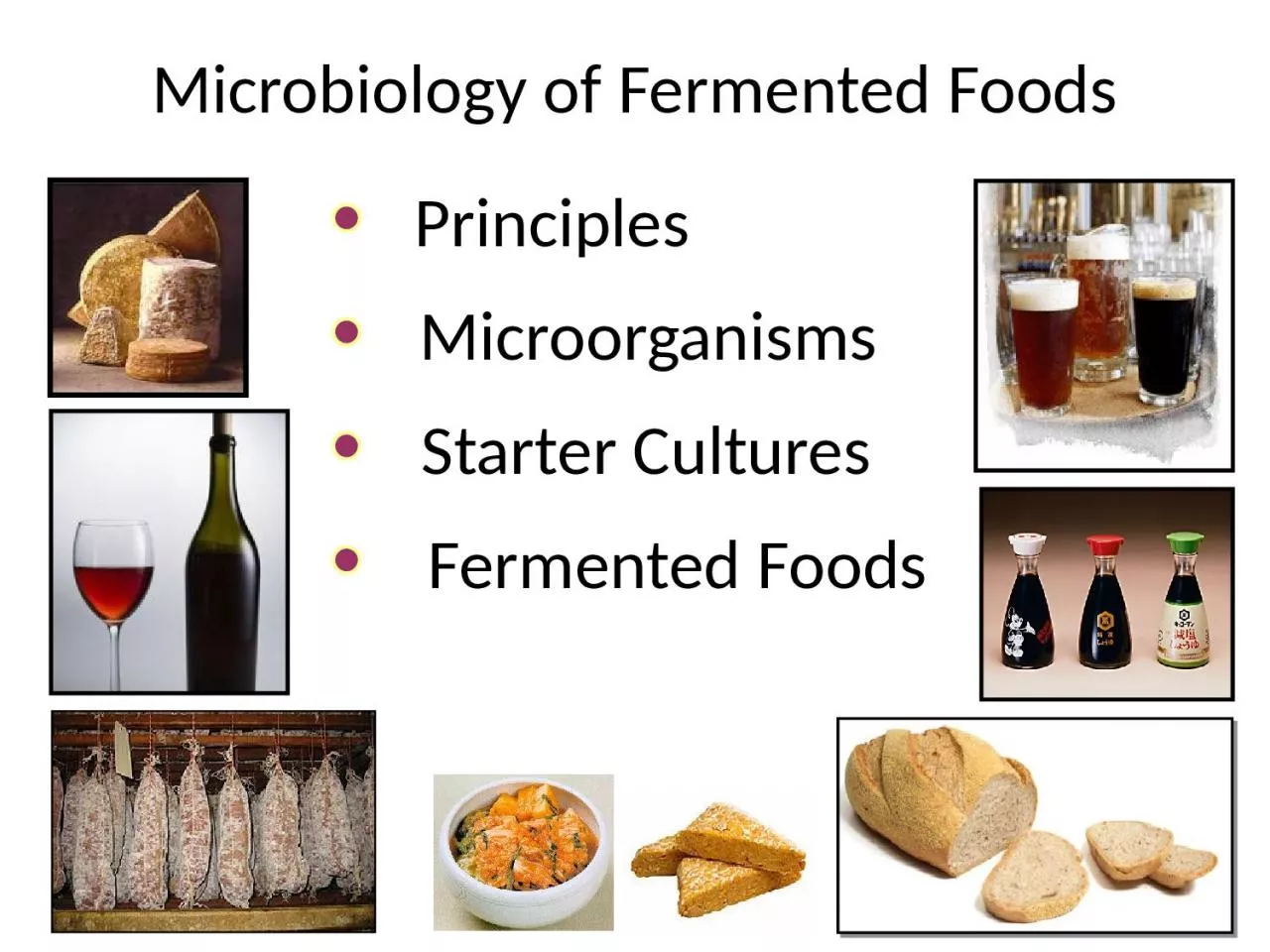

Principles Microorganisms Starter Cultures Fermented Foods Fermentation Principles Spoilage versus Fermentation a matter of control Left to their own fate perishable foods meat milk fruits and vegetables perish because growth of microorganisms is not controlled ID: 929520
Download Presentation The PPT/PDF document "Microbiology of Fermented Foods" is the property of its rightful owner. Permission is granted to download and print the materials on this web site for personal, non-commercial use only, and to display it on your personal computer provided you do not modify the materials and that you retain all copyright notices contained in the materials. By downloading content from our website, you accept the terms of this agreement.
Slide1
Microbiology of Fermented Foods
Principles
Microorganisms
Starter Cultures
Fermented Foods
Slide2Fermentation Principles
Spoilage versus Fermentation: a matter of
control
Left to their own fate, perishable foods (meat, milk, fruits and vegetables) perish because growth of micro-organisms is not controlled
In fermentation, conditions are controlled so that only certain microorganisms can grow (only those that bring about positive changes).
Slide3Spoilage versus Fermentation:
a matter of control
Acidity and pH
Temperature
Moisture
Salt
Exert control by:
Substrate availability
Slide4General properties of fermented foods
Enhanced nutritional value
Enhanced functionality
Enhanced organoleptic properties
Enhanced
preservation
Unique
Increased economic value
Slide5Exposed and open
Exposure to contaminants
Varying quality
Safety a minor concern
Manual
Insensitive to time
Closed and contained
Contaminants excluded
Consistent quality
Safety a major concern
Automated
Time-sensitive
Non-sterile medium
Small scale (craft industry)
Traditional
Modern
Heat-treated medium
Large scale (in factories)
Fermented foods industry: past and present
Slide6Microorganisms involved in fermented foods
Lactic acid bacteria
(
Lactobacillus, Streptococcus
)
Other bacteria
(
Propionibacterium
,
Brevibacterium
)
Fungi
(
Aspergillus, Penicillium
)
Yeast
(
Saccharomyces
)
Slide7Initiating food fermentations
natural fermentation
starter cultures
backslopping
wine, sauerkraut, soy sauce
relies on use of a previous batch
defined strains in concentrated form
requires selection
sausage, sour dough bread, beer, kefir
cheese, yogurt, sausage, wine, beer, bread
Slide85.0 µm
A
D
E
B
1.0 µm
F
C
Lactic acid bacteria
A,
Lactobacillus delbrueckkii
subsp.
bulgaricus
; B.
Lactobacillus brevis
; C,
Pediococcus pentosaceus
; D,
Lactococcus lactis
; E,
Lactobacillus helveticus
; F,
Streptococcus thermophilus
Slide9Common characteristics of lactic acid bacteria
Gram positive rods and cocci
Acid-tolerant
Fermentative
Non-sporeforming
Catalase negative
Low mol% G + C
Non-motile
Facultative anaerobes
Slide10Nutritional requirements of lactic acid bacteria
Some strains require anaerobiois
Require sugars for energy
Some strains require complex nutrients
Require pre-formed amino acids
Slide11lactate
acetate
CO
2
lactate
(
L or D)
ethanol
Homofermentative
Heterofermentative
Glucose
Fermentative pathways in lactic acid bacteria
Slide12Lactobacillus
Tetragenococcus
Pediococcus
Enterococcus
Vagococcus
Carnobacterium
Oenococcus
Leuconostoc
Lactococcus
Weissella
Streptococcus
Aerococcus
Genera of lactic acid bacteria
Slide13Lactobacillus
Tetragenococcus
Pediococcus
Oenococcus
Leuconostoc
Lactococcus
Streptococcus
Lactic acid bacteria important in fermented foods
Slide14Lactobacillus delbrueckii
Staphylococcus aureus
Bacillus subtilis
Listeria monocytogenes
Tetragenococcus halophilus
Lactobacillus casei
Lactobacillus brevis
Pediococcus pentosaceus
Lactobacillus plantarum
Lactobacillus gasseri
Lactobacillus johnsonii
Enterococcus faecalis
Vagococcus salmoninarum
Carnobacterium funditum
Aerococcus viridans
Oenococcus oeni
Leuconostoc mesenteroides
Weissella cibaria
Clostridium botulinum
Phylogeny of lactic acid and other Gram positive bacteria
Lactococcus lactis
Lactococcus cremoris
Streptococcus pneumoniae
Streptococcus thermophilus
Slide15Habitats of lactic acid bacteria
Dairy
Meat
Vegetable
Fruit
Lactococcus
Streptococcus
Leuconostoc
Oenococcus
Lactobacillus
Pediococcus
Tetragenococcus
+
-
+
+
+
-
-
-
-
-
-
-
-
+
+
+
+
+
-
-
-
-
-
-
+
+
+
+
Genus
Slide16General functions of LAB in fermented foods
Ferment sugars, reduce pH
Synthesis of flavor compounds
Texture changes
Production of antimicrobial substances